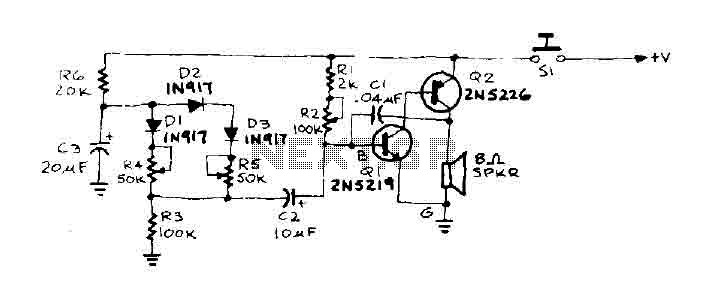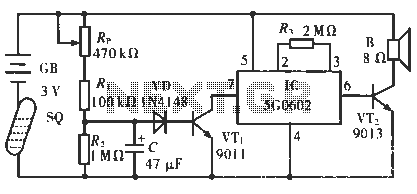
Precision Monostable Multivibrator Circuit

A monostable multivibrator using the IC CD4538 is a precision device that functions as a monostable/astable multivibrator and is designed to avoid false triggering. This IC is suitable for various applications requiring precise timing cycles. The CD4538 offers improved reliability compared to the commonly used timer IC 555. In this configuration, the IC is set up as a short-duration monostable timer, utilizing resistors R1 and capacitor C1 as timing components. With the specified values, the output of IC1 remains low for a duration of three minutes. By altering the values of C1 or R1, different time intervals can be achieved. Unlike the 555 IC in monostable mode, the output of the CD4538 initially goes high upon power-up and transitions to low when a low-to-high transition pulse is applied to the trigger pin (pin 5). When switch S1 is pressed, the high-going pulse triggers the IC, causing its output to go low. This output drives the load through the PNP transistor T1, which can be connected to various devices such as an LED or a buzzer.
The CD4538 monostable multivibrator circuit is designed for applications where precise timing is essential. The circuit configuration typically includes the IC, a resistor (R1), and a capacitor (C1) to define the timing characteristics. The timing interval, which is determined by the RC time constant, can be calculated using the formula T = 0.7 * R1 * C1, where T is the time duration for which the output remains low.
In operation, upon powering the circuit, the output of the CD4538 is high, indicating that the circuit is ready to accept a trigger. The trigger is applied through pin 5, which is connected to the switch S1. When S1 is pressed, it sends a low-to-high transition pulse to the trigger pin, causing the output to drop low and remain in that state for the duration defined by the RC components.
The output pin of the CD4538 can be connected to a PNP transistor (T1), which acts as a switch for the load. The load can be an LED, which will turn on during the low output state of the IC, or a buzzer that will sound for the same duration. The PNP transistor is biased correctly to ensure that it turns on when the output of the CD4538 is low, allowing current to flow through the load.
This circuit can be utilized in a variety of applications, including timers, pulse generators, and event counters, where accurate timing control is paramount. The flexibility of adjusting R1 and C1 values allows for easy customization of the timing interval to suit specific requirements. Additionally, the CD4538's immunity to false triggering enhances the reliability of the circuit in practical applications.A monostable multivibrator using IC CD4538. It is a precision monostable/astable multivibrator IC free from false triggering. This can be used for various application in which precise timing cycle is required. CD4538 is the precision monostable/astable multivibrator IC that is free from false triggering. It is more reliable than the popula r timer IC 555. Here the IC is wired as a short duration monostable timer using R1 and C1 as timing components. With the given values, output of IC1 remains low for three minutes. By changing the value of C1 or R1 various time intervals can be obtained. Unlike 555 IC in the monostable mode, here in CD4530, output of IC becomes high at power on and becomes low when the trigger pin5 gets a low-to-high transition pulse. When S1 is pressed, the high going pulse triggers IC and its output goes low. This drives the load through the PNP transistor T1. Load can be an LED, Buzzer etc. 🔗 External reference
The CD4538 monostable multivibrator circuit is designed for applications where precise timing is essential. The circuit configuration typically includes the IC, a resistor (R1), and a capacitor (C1) to define the timing characteristics. The timing interval, which is determined by the RC time constant, can be calculated using the formula T = 0.7 * R1 * C1, where T is the time duration for which the output remains low.
In operation, upon powering the circuit, the output of the CD4538 is high, indicating that the circuit is ready to accept a trigger. The trigger is applied through pin 5, which is connected to the switch S1. When S1 is pressed, it sends a low-to-high transition pulse to the trigger pin, causing the output to drop low and remain in that state for the duration defined by the RC components.
The output pin of the CD4538 can be connected to a PNP transistor (T1), which acts as a switch for the load. The load can be an LED, which will turn on during the low output state of the IC, or a buzzer that will sound for the same duration. The PNP transistor is biased correctly to ensure that it turns on when the output of the CD4538 is low, allowing current to flow through the load.
This circuit can be utilized in a variety of applications, including timers, pulse generators, and event counters, where accurate timing control is paramount. The flexibility of adjusting R1 and C1 values allows for easy customization of the timing interval to suit specific requirements. Additionally, the CD4538's immunity to false triggering enhances the reliability of the circuit in practical applications.A monostable multivibrator using IC CD4538. It is a precision monostable/astable multivibrator IC free from false triggering. This can be used for various application in which precise timing cycle is required. CD4538 is the precision monostable/astable multivibrator IC that is free from false triggering. It is more reliable than the popula r timer IC 555. Here the IC is wired as a short duration monostable timer using R1 and C1 as timing components. With the given values, output of IC1 remains low for three minutes. By changing the value of C1 or R1 various time intervals can be obtained. Unlike 555 IC in the monostable mode, here in CD4530, output of IC becomes high at power on and becomes low when the trigger pin5 gets a low-to-high transition pulse. When S1 is pressed, the high going pulse triggers IC and its output goes low. This drives the load through the PNP transistor T1. Load can be an LED, Buzzer etc. 🔗 External reference





